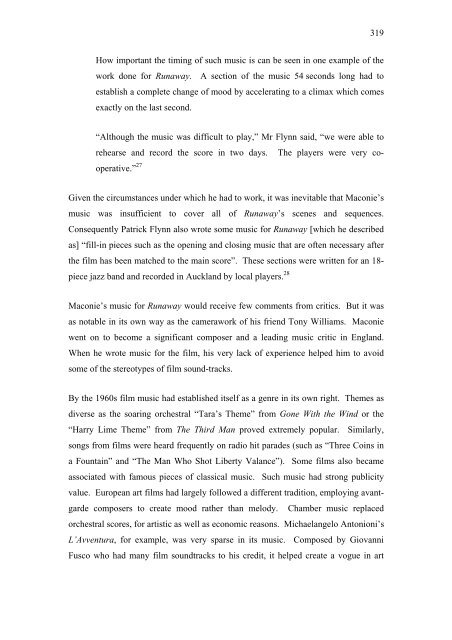Copyright Statement - ResearchSpace@Auckland
Copyright Statement - ResearchSpace@Auckland
Copyright Statement - ResearchSpace@Auckland
Create successful ePaper yourself
Turn your PDF publications into a flip-book with our unique Google optimized e-Paper software.
319<br />
How important the timing of such music is can be seen in one example of the<br />
work done for Runaway. A section of the music 54 seconds long had to<br />
establish a complete change of mood by accelerating to a climax which comes<br />
exactly on the last second.<br />
“Although the music was difficult to play,” Mr Flynn said, “we were able to<br />
rehearse and record the score in two days. The players were very co-<br />
operative.” 27<br />
Given the circumstances under which he had to work, it was inevitable that Maconie’s<br />
music was insufficient to cover all of Runaway’s scenes and sequences.<br />
Consequently Patrick Flynn also wrote some music for Runaway [which he described<br />
as] “fill-in pieces such as the opening and closing music that are often necessary after<br />
the film has been matched to the main score”. These sections were written for an 18piece<br />
jazz band and recorded in Auckland by local players. 28<br />
Maconie’s music for Runaway would receive few comments from critics. But it was<br />
as notable in its own way as the camerawork of his friend Tony Williams. Maconie<br />
went on to become a significant composer and a leading music critic in England.<br />
When he wrote music for the film, his very lack of experience helped him to avoid<br />
some of the stereotypes of film sound-tracks.<br />
By the 1960s film music had established itself as a genre in its own right. Themes as<br />
diverse as the soaring orchestral “Tara’s Theme” from Gone With the Wind or the<br />
“Harry Lime Theme” from The Third Man proved extremely popular. Similarly,<br />
songs from films were heard frequently on radio hit parades (such as “Three Coins in<br />
a Fountain” and “The Man Who Shot Liberty Valance”). Some films also became<br />
associated with famous pieces of classical music. Such music had strong publicity<br />
value. European art films had largely followed a different tradition, employing avantgarde<br />
composers to create mood rather than melody. Chamber music replaced<br />
orchestral scores, for artistic as well as economic reasons. Michaelangelo Antonioni’s<br />
L’Avventura, for example, was very sparse in its music. Composed by Giovanni<br />
Fusco who had many film soundtracks to his credit, it helped create a vogue in art















